List of Olympic torch designs
This is a list of torch designs used at the Olympic games.
Summer Olympic torch designs
| Games | Host | Design | Designer(s) | Manufacturer | Length (cm) |
Weight (g) |
Numbers produced | Image | Ref |
|---|---|---|---|---|---|---|---|---|---|
| 1936 | Berlin, Germany | Walter Lemcke and Peter Wolf |
Friedrich Krupp AG | 27 | 450 | 3,840 |  |
[1] | |
| 1948 | London, Great Britain | Ralph Lavers | 47 | 960 | 1,688[lower-alpha 1] | |
[2] | ||
| 1952 | Helsinki, Finland | Aukusti Tuhka | Kultakeskus Oy, Hämeenlinna | 60 | 600 | 22 | [3] | ||
| 1956 | Melbourne, Australia | Ralph Lavers | 47 | 960 | 400[lower-alpha 1] | |
[4] | ||
| 1960 | Rome, Italy | The torch was designed to bring back the traditions of the antique torches of Ancient Rome. It was made from aluminum and covered with bronze. Weighing a total of 580 grams, it was one of the lightest torches. | Pier Luigi Nervi and Amedeo Maiuri | Curtisa, Bologna | 40 | 580 | c. 1,500 |  |
[5] |
| 1964 | Tokyo, Japan | The minimalistic design of the torch was dedicated to the trends which were in fashion in the sixties. With a handle separated from the 'shaft' of the torch by a round sword, it resembled a fencing sword. | Kenzo Tange | 64.5 | 836 | 5,244 | |
[6][7] | |
| 1968 | Mexico City, Mexico | The torch resembles a potato masher with the words Mexico 68 on the top. The size of this torch was all of 52 cm. | James Metcalfe | 52.3 | 780 | 3,000[lower-alpha 2] |  |
[8] | |
| 1972 | Munich, Germany | The Olympic rings with the text "'München 1972 Spiele der XX. Olympiade'" on the handle. The logo on the upper surface of the plate. The entire surface of the torch is completely nickel-plated. It resembles a top and a sword. The logo represents the sun, the moon and the stars. A liquid gas was used for the burning. | Hagri Kettwig | Friedrich Krupp AG | 75 | 1350 | 5,917 | |
[9] |
| 1976 | Montreal, Canada | The torch was primarily made of aluminium and weighed 836 grams. It was fuelled by olive oil in part to further strengthen the link to the Greek origins of the events. This torch resembles a microphone. The holes represents the aboriginals of Canada. Red represents Canada and the ethnic groups of the country. | Georges Huel and Michel Daillaire |
Queensway Machine Products | 66 | 836 | 1,250[lower-alpha 3] | 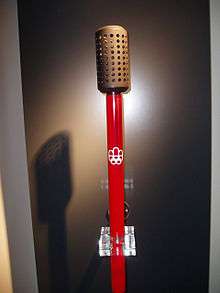 |
[10] |
| 1980 | Moscow, Soviet Union | The Olympic torch resembles a comet. The colors represents the four seasons. White represents the Autumn and Winter. Gold represents Spring and Summer. It has the words Москва-Олимпиада-80 on the white and the logo on the golden protective cover. Eventually the torch was "polished". In the USSR, a patent of invention was registered for the torch with the number 729414. | Boris Tutschin | Leningrad Department of the Ministry of Aircraft Production | 56.5 | 700 | 5,000[lower-alpha 1] |  |
[11] |
| 1984 | Los Angeles, U.S. | It resembles a blueprint. Etched on the ring of the torch were the words of the Olympic motto ("Citius, Altius, Fortius") with the Olympic rings between each word. It features the plaque of the Los Angeles Memorial Coliseum and the Olympic Cauldron. This gives clues to the torchbearers on what the cauldron would look like. | Turner Industries | 56.5 | 1,000 | 4,500 | |
[12] | |
| 1988 | Seoul, South Korea | The design of the torch, engraved with two dragons symbolizing the harmony of East and West. Korean traditions were taken into account in the making of the entire external appearance of the torch. The unique character of the torch is in the leather sheath of the handle. | Lee Woo-Sung | Korea Explosive Co. Ltd | 50.5 | 1,000 | 3,300 | |
[13] |
| 1992 | Barcelona, Spain | It resembles a flower pot and a cauldron. It has the words XXV Olimpiada Barcelona 1992 and the logo. | André Ricard | Kromschröder | 68 | 1,200 | 9,444 [lower-alpha 4] |  |
[14] |
| 1996 | Atlanta, U.S. | It resembles a Greek column. It features 22 aluminum "reeds" intended to represent the number of times that the Games had been held. A gold-plated band towards the base of the torch features the names of all 20 host cities up to and including Atlanta while the logo is etched into another band near the top. The handle, made of Georgia hardwood, is found near the center of the 76 centimetres (30 in) torch. The Paralympic torch resembles a Native American arrow. It features the logos of the Paralympics on silver top and the Paralympic taeguks on the silver arrowhead. It was the words 1996 NationsBank Paralympic Torch Relay on the wooden center. | Malcolm Grear | 76 | 1,600 |  |
[15] | ||
| 2000 | Sydney, Australia | The design of the Olympic and the Paralympic torches reflected three famed areas of Australian culture: the boomerang, the Sydney Opera House, and the waters of the Indian and the Pacific Oceans. The concept also reflected the elements of earth, fire, and water. The Paralympic torch reflects the history, nature, cities, states and people of the host country. | Robert Jurgens | G.A. & L Harrington Pty Ltd. | 72 | 1,000 | 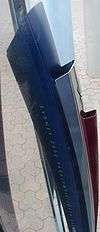 |
[16] | |
| 2004 | Athens, Greece | The torch was inspired by an olive tree leaf. The design was selected to enhance the flame with its upward dynamic shape. Its ergonomic curved design establishes the torch as the continuation of the flame, which in turn rises as a continuation of the torchbearer's hand. It is made of metal (magnesium) and wood (olive tree). It also represents the fire seemed to come straight from the torchbearer's hand. | Andreas Varotsos | 68 | 700 | |
[17] | ||
| 2008 | Beijing, China | It is based on traditional scrolls and uses a traditional Chinese design known as "Lucky Cloud". It designed in reference to the traditional Chinese concept of the five elements that make up the entire universe. Red is the traditional color of China. A maroon version was produced for the Paralympic torch. It references the yin and yang. The top of the torches represents the rivers, lakes, waterfalls, the Four Seas and the ocean of China. The bottom of the torches represents the people, animals, forests, mountains, deserts, buildings, cities, towns and villages of China. The logo is on the center of the torch. The clouds represents the ethnic minorities of the host country. It has the words Beijing 2008 on the red/maroon bottom. | A team from Lenovo Group, public Company, Beijing |
Vatti Corporation Ltd | 72 | 980 | 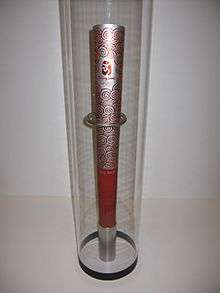 |
[18] | |
| 2012 | London, United Kingdom | The 2012 Olympic and Paralympic Torches were made of aluminum alloy skin, perforated by 8,000 circles to represent the 8,000 torchbearers who would carry the flame. The circles also helped to dissipate heat without it being conducted down the handle, and provided extra grip. The triangular shape of torches represents the three Olympic values (respect, excellence and friendship), elements of the Olympic motto - faster, higher, stronger, Olympic Games hosted by the United Kingdom (1908, 1948 and 2012), tri-vision of the 2012 Summer Olympics and Paralympics (sport, education and culture) and the Paralympic agitos. The Olympic torch is gold while the Paralympic torch is silver. | Edward Barber and Jay Osgerby |
80 | 800 without canister 1,090 with canister |
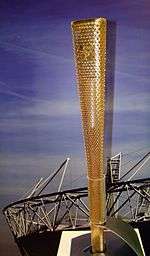 |
[19] | ||
| 2016 | Rio de Janeiro, Brazil | When the white torch is lit (according to the creators, known as the "kiss"), Its segments will open up. The segments come from the elements of the Brazilian flair and the host city's nature represent with the colors of the host nation's flag (or the sun in the Paralympic torch). The golden triangle on the top of the torch represents the three Olympic values (respect, excellence and friendship), the achievement of the games, the Paralympic agitos and the sun. The green (gold in the Paralympic torch) represents nature surrounding the host city. The aquamarine (orange in the Paralympic torch) represents the waters surrounding the host nation and the host city. The blue (red in the Paralympic torch) represents the sea. The light blue (pink in the Paralympic torch) and the shape of the segments represents the esplanades (Calçadão in Portuguese) of Copacabana and Ipanema. The axis of the torch expresses unity and diversity. The four Paralympic values (courage, determination, inspiration and equality) are written in Braille on the Paralympic torch. | Chelles & Hayashi | Recam Làser | 69 | 1,500 | 12,000 |  |
|
Winter Olympic torch designs
| Games | Host | Design | Designer(s) | Manufacturer | Length (cm) |
Weight (g) |
Numbers produced | Image | Ref |
|---|---|---|---|---|---|---|---|---|---|
| 1952 | Oslo, Norway | A map. At the "neck" of the torch, there were five Olympic rings and an inscription "Morgedal-Oslo". This torch is one of the lightest. | 22.8 | 95 | [20] | ||||
| 1956 | Cortina d'Ampezzo, Italy | The classic design of the torch was meant to emphasize the link with ancient Greek traditions. | 47 | 820 | 31,18 | [21] | |||
| 1960 | Squaw Valley, U.S. | John Hench, a Disney imagineer | 48.5 | 1,320 | 700 | [22] | |||
| 1964 | Innsbruck, Austria | The torch resembles the shape of the torches which existed in the 19th Century. The continuity of the flame burning was provided by a special content known as "Tipizir 120/140". Thanks to this, the flame was able to burn for 22 hours non-stop. | 61 | 22.0 | |||||
| 1968 | Grenoble, France | The torch was made from sheet copper that was covered in bronze. The knob at the end of the torch reliably shielded the torchbearers from accidental burns. It was calculated that during the torch relay, 75 tons of oil were used to maintain the flame. | 76 | 17.0 | 50,00 | ||||
| 1972 | Sapporo, Japan | The torch is an obvious departure from the traditions of Japanese minimalism. Sapporo's torch is rather a futuristic creation. It resembles a spaceship. The barrel with the flame with a length of 55 cm is twisted into the massive handle | Sori Yanagi | Mizuno Corporation | 55 | 460 | 16,300 | ||
| 1976 | Innsbruck, Austria | The torch was decorated by a three-dimensional Olympic emblem with the five rings. There was no basin on this torch; instead, there was a wide ring below, separating the handle from the "stalk". | 74.6 | 900 | 12,00 |  |
|||
| 1980 | Lake Placid, U.S. | The torch was designed to resemble a Calla. The silver represents the United States' skyscrapers, transportation, military and NASA. The gold represents its people, sports, agriculture and the presidents. The orange leather presents its past and the bald eagle. | 73 | 10.80 | 52 | |
|||
| 1984 | Sarajevo, Yugoslavia | The torch was made in a minimalist style and a simple metallic tube with a handle. It resembles a satellite and a solar panel. The gold represents the Olympic spirit. While the silver represents the snow and the clouds. | Mizuno Corporation | Mizuno Corporation | 57.7 | 780 | 16,00 | 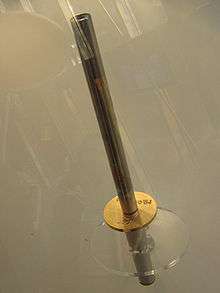 |
|
| 1988 | Calgary, Canada | Calgary Tower. It bares the motto, Citius, Altius, Fortius and pictograms of the sports. The handle of the torch was made of maple, a tree symbolizing Canada. | 50.0 | 10.0 | 20,899 | 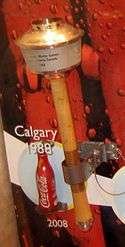 |
|||
| 1992 | Albertville, France | This torch resembles a horn of a bull or a flame (if turned upside down). It bears the name of the games in French, XVIes Jeux Olympiques D'Hiver Savoie France. This torch is the lightest in Olympic history. It was produced from steel with gold plating. With a height of 41 cm, it became one of the shortest torches in the history of the Games. | Philippe Starck | 41 | 13.0 | 55,000 | |||
| 1994 | Lillehammer, Norway | The torch is a reminder of man's mastery over fire; a flaming branch is dragged out of the fire, and as it is raised the flame travels up its length. When you run with such a branch, it burns like a flaming flag. Norwegian craftmanship has been applied to the design of the Olympic torch. Like a sheath knife; it consists of a long wooden handle and a metal blade. The birchwood handle is the product of a long tradition in Norway, and the 'blade' of polished aluminium is a reflection of modern industry and technology. The long supple shape echoes that of the torch-bearer; the torch is more than a burning flame. The proportions are all-important: its length in relation to the human body gives it an elegance and a flow that would be lacking in a shorter torch, and torch and body together form a unit. It features the pictograms inside the metal blade. This torch is the thinnest as well as the longest. Its length was one and a half meters - almost the height of a person. The torch's handle was made from Norwegian birch, and the basin was metal. The creators of this torch came up with the poetic name "Noble" for it. | André Marandon and Paal Johan Kahrs | Paal J Kahrs Arkitekter AS | 18.4 | 12.0 | 70,000 | ||
| 1998 | Nagano, Japan | A taimatsu (a Japanese torch), the silver body’s hexagonal form symbolizes snowflakes. It features the Nagano 1998 logo, the word "'Nagano 1998"', and the pictograms of the sports at the bottom. The top features golden Olympic Rings. The Paralympic torch has blue, red, yellow rings. The colors represent the colors of the taegueks. It resembles a bonshō (a Japanese bell). (if turned upside down) | Akio Haruhara | 55.0 | 15.00 | 69,01 | |
image | |
| 2002 | Salt Lake City, U.S. | An icicle. The top section was glass, and the Olympic Flame burned within the glass, echoing the 2002 Olympic theme Light the Fire Within. The glass stood for purity, winter, ice, and nature. Also inside the glass was a geometric copper structure which helped hold the flame. Copper is a very important natural element of Utah, and represented fire, warmth, Utah's History, and mirrored the orange/red colors of the theme Fire and Ice. The center section was made of silver and finished to look old and worn, while the bottom section was made of clean, highly polished silver. The center section represented the silver mining heritage of the American West, while the bottom section represented the future and modern technology. The Torchbearer gripped the torch at the junction of both the aged and polished silver, during which their hand represented a bridge from the past to the present. The two silver sections also mirrored the blue/purple colors of the Fire and Ice theme. It bears the Salt Lake City 2002 logo, the motto of the games on the silver bottom, light the fire within, the Roman numbers for the number 19, XIX and the name of the Olympic Games, Olympic Winter Games Salt Lake Ciy 2002 with the Olympic rings in the middle. The Paralympic version has minor differences from the Olympic torch, it bears the Salt Lake City 2002 Paralympics logo, the motto of the games on the metal bottom, Mind, Body, Spirit, the Roman numbers for the number 8, VIII and the name of the Paralympic Games, Paralympic Winter Games Salt Lake Ciy 2002 with the Paralympic taegeuks in the middle. | Axiom Design | Coleman Company | 83.5 | 13.00 | 12,000 |  |
|
| 2006 | Torino, Italy | A ski pole, alpenstock and a mountain peak. The 12 holes represents the Mole Antonelliana. It features the Torino 2006 logo, while the Paralympic torch features the Torino 2006 Paralympic Games logo. The torch was criticized for being too heavy. | Pininfarina | Pininfarina | 76.5 | 18.50 | 11,000 | |
|
| 2010 | Vancouver, Canada | The lines of a skier's turns carved in the snow and the undulating beauty of Canada's winter landscape. It bears the red maple leaf in front and the motto of the games at the back, With glowing hearts/Des plus brillants exploits. A grey version of the torch is for the Paralympic torch. The steel blue Paralympic torch resembles a grey curved cloud and the mountains surrounding Vancouver. The torch also represents the souls of the host city, host province and the host country. | Leo Obstbaum | Bombardier Inc. | 94.5 | 66.0 | 12,000 | |
|
| 2014 | Sochi, Russia | a feather of a firebird. Silver in the design represented ice while the Red is the traditional colour of Russian sport and symbolizes the fire kindling in the mountains that surround the holiday resort. A Sky Blue version of the torch is for the Paralympic torch. Sky Blue symbolizes the strength and spirit of the Paralympic Movement and the harmony, commitment and energy of the Paralympic athletes. After the torch relays, many torchbearers complained about their weight - the torches weighed more than two kilograms. | a team of famous Russian designers and engineers | 95.0 | 18.0 | 15,000 | .png) |
||
Summer Youth Olympic torch designs
| Games | Host | Design | Designer(s) | Manufacturer | Length (cm) |
Weight (g) |
Numbers produced | Image | Ref |
|---|---|---|---|---|---|---|---|---|---|
| 2010 | Singapore | Red on the top of the torch represented youths' passion and "burning desire to learn and excel, blazing the trail in life" (Blazing the Trial was the tagline of the games). White represents the sky. Water in the bottom represented Singapore, which is an island country surrounded entirely by water bodies and which had its origins as a seaport; it also reflected the "vibrant and dynamic nature" of the city-state. | Vatti Corporation Ltd | 60 | 560 | 2,400 | image | ||
| 2014 | Nanjing, China | Nicknamed the Door of Happiness. The main body of the torch is covered in the metallic luster. And the torch is extremely light. The silver-colored part is designed into the shape of letter “n”, which is the initial of the city’s name, Nanjing, and is also in the shape of the city gate of the Ming Dynasty, symbolizing Nanjing’s hope to present its grandeur and brilliance to the world through the games. The blue part represents the Yangtze River, the water of which passes through the gate. The gray strips at the bottom of the torch are the symbol of ripples, rendering the torch more dynamic. | Ji Ziyi | Vatti Corporation Ltd | 50 | 560 | 2,400 | ||
Winter Youth Olympic torch designs
| Games | Host | Design | Designer(s) | Manufacturer | Length (cm) |
Weight (g) |
Numbers produced | Image | Ref |
|---|---|---|---|---|---|---|---|---|---|
| 2012 | Innsbruck, Austria | White represents snow and world peace. The pixels represents the soul of the countries, athletes and the people. The colors of the pixels represents each colors from the flags of the NOCs' countries. | Vatti Corporation Ltd | 60 | 560 | 2,012 | image | ||
| 2016 | Lillehammer, Norway | The blue triangles represents the ice and white represents snow. | Vatti Corporation Ltd | 60 | 560 | ||||
Footnotes
| Wikimedia Commons has media related to Olympic torches. |
- Notes
References
- ↑ "Olympic-museum 1936 torch". Retrieved 2013-11-07.
- ↑ "Olympic-museum 1948 torch". Retrieved 2013-11-07.
- ↑ "Olympic-museum 1952 torch". Retrieved 2013-11-07.
- ↑ "Olympic-museum 1956 torch". Retrieved 2013-11-07.
- ↑ "Olympic-museum 1960 torch". Retrieved 2013-11-07.
- ↑ "Olympic-museum 1964 torch". Retrieved 2013-11-07.
- ↑ "1952 Summer Olympics Torch – Tokyo". Retrieved 2013-11-08.
- ↑ "Olympic-museum 1968 torch". Retrieved 2013-11-07.
- ↑ "Olympic-museum 1972 torch". Retrieved 2013-11-07.
- ↑ "Olympic-museum 1976 torch". Retrieved 2013-11-07.
- ↑ "Olympic-museum 1980 torch". Retrieved 2013-11-07.
- ↑ "Olympic-museum 1984 torch". Retrieved 2013-11-07.
- ↑ "Olympic-museum 1988 torch". Retrieved 2013-11-07.
- ↑ "Olympic-museum 1992 torch". Retrieved 2013-11-07.
- ↑ "Olympic-museum 1996 torch". Retrieved 2013-11-07.
- ↑ "Olympic-museum 2000 torch". Retrieved 2013-11-07.
- ↑ "Olympic-museum 2004 torch". Retrieved 2013-11-07.
- ↑ "Olympic-museum 2008 torch". Retrieved 2013-11-07.
- ↑ "Olympic-museum 2012 torch". Retrieved 2013-11-07.
- ↑ "1952 Winter Olympics Torch – Oslo". Retrieved 2013-11-07.
- ↑ "1956 Winter Olympics Torch – Cortina d'Ampezzo". Retrieved 2013-11-22.
- ↑ "1960 Winter Olympics Torch – Squaw Valley". Retrieved 2013-11-22.
This article is issued from Wikipedia - version of the 9/30/2016. The text is available under the Creative Commons Attribution/Share Alike but additional terms may apply for the media files.